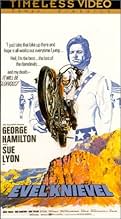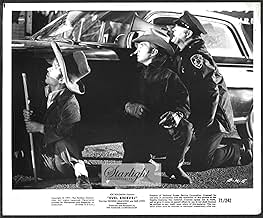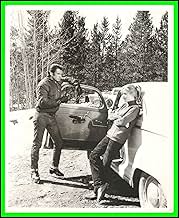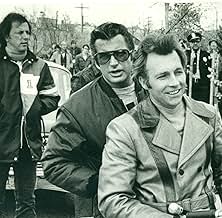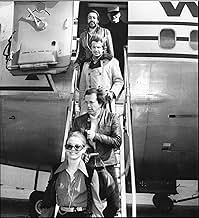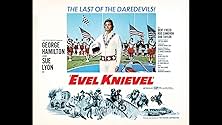Aggiungi una trama nella tua linguaBiography of the famed motorcycle daredevil, much of which was filmed in his home town of Butte, Montana. The film depicts Knievel reflecting on major events in his life just before a big ju... Leggi tuttoBiography of the famed motorcycle daredevil, much of which was filmed in his home town of Butte, Montana. The film depicts Knievel reflecting on major events in his life just before a big jump.Biography of the famed motorcycle daredevil, much of which was filmed in his home town of Butte, Montana. The film depicts Knievel reflecting on major events in his life just before a big jump.
- Nurse #1
- (as Alana Collins-Hamilton)
- Wrangler #1
- (as Lee De Broux)
Recensioni in evidenza
This film is not really an Evel Knieval biopic; it is really a study in the culture that makes Knieval possible. The makers of this film - primarily producer-star Hamilton - understand that in the 20th century, Americans developed an unhealthy fascination for 'sports' wherein the performers flirted with death; this could only make sense if some of the performers actually did die. The performers themselves well understood that, but all believed they were invincible, that therefore they were manipulating the secret desire of the audience rather than satisfying it. However, inevitably some - like the rodeo bull-rider early in this film - just did die; no human is invincible, after all.
How do film-makers address such a culture without getting cynical or preachy about it? You take one such 'sports'-star and take him on face-value. The ground of this film is the Evel Knieval legend that Knieval himself was hyping at every opportunity - it is simply arraigned in a way that many of his tall-tales reveal themselves as just 'too much' for their own good - even if true, why would anybody do that? Finally, one has to note that this is a fine specimen of a film made specifically for the drive-in circuit: clearly enunciated dialog (those car-speakers), over-lit (has to play against moonlight), fast-paced, careful avoidance of close-ups (only Sergio Leone's were able to hold attention at the drive-in), sweeping scenery, episodic (plenty opportunities for couples to neck), and none too deep.
Bottom-line: I first saw this film 20 years ago and only recently saw it again; neither the film nor my opinion of it has changed much all those years - there must be something that still works here.
In dissecting the movie and comparing it to Knievel's real life, most reviewers miss the real point of this film, I think. Knievel was at the peak of his popularity. Every stunt he did was to make money. He had a sense of showmanship about it. And, he had a huge ego. Already he had suffered many of the 300 plus broken bones in his life. He wouldn't be able to work as a daredevil much longer. So, the time was right for a movie on the legend.
I don't know how the Knievel and Hamilton connection came about. Surely, Knievel must have provided a lot of information for this film. His background and trouble with the law while growing up in Butte, MT, isn't ignored; but is treated lightly and with a sense of humor. Knievel was known to espouse some values for children – about keeping away from drugs. Whether or not that's how he truly felt, he did in fact issue his warnings in public. It may have been part of his showman persona, but it was effective in helping paint an image of a daredevil hero. Later in life, Knievel assaulted and badly beat an author with a baseball bat. The public soon learned that his private life was far different from his public persona.
But this movie is about Knievel's early life and rise to legend status. I think George Hamilton nailed the character in this film. He moves between deadpan seriousness, humor, and anxiety with ease. That must have been how the real Evel Knievel was – in the minds of viewers, but also in the glossy hype about the legend. Sue Lyon and Bert Freed do well in their roles. Most of the incidents in the film actually happened. But, how much of the details are fact or fiction – who knows?
Now, for the historic jump that took place three years after this film. I remember watching it on TV. I don't recall if it was live (closed circuit) or a news cast, but the program showed Knievel's jump across the Snake River Canyon about five miles east of Twin Falls, Idaho. His cycle looked more like a rocket ship than a motorcycle. It was built specifically for the jump. The canyon at that point was about 1,600 feet across – from edge to edge; but the jump trajectory was 3,500 feet. Kneivel rocketed from South to North and he actually made it across the canyon. But his safety parachute had opened right at lift off and the drag held him up enough that strong northwest winds carried him back over the canyon where he descended to the floor. He came to rest just outside the waters and walked out without a scratch.
I've been to the Snake River Canyon jump site. Today, a monument is located there. It's about five miles east of Twin Falls, ID. Take I-84 exit 173 and go south toward Idaho Falls about three miles. Watch for signs at the bridge over the Snake River Canyon. Follow the falls road to the jump site. While there, a visit to Shoshone Falls Park is a must. The falls are very impressive.
George Hamilton in 1971 didn't seem to know how to act, he swaggered humorlessly and proclaimed, and chewed gum like Burt Reynolds. John Milius and a 90 year old Englishman scripted this, so Evel's lines are filled with references and heightened language that are quite outside the range of a dropout sociopath. And yet this movie isn't dead. It has an intentness, a brio, a sort of-- pertness. It deserves to have eyeballs given to it, over a few sittings, over a few lunch hours, using the DVD feature of your workstation in your cubicle. Go to your supermarket today!
George Hamilton is perfectly cast in the role of the titular daredevil. His smirking attitude toward danger, bodily injury, and dismemberment, breathes life into the legend that is Bobby "Evel" Knievel. We're treated to the story via flashbacks. Hamilton's Knievel is a man who knows his destiny lies in superstardom through increasingly hazardous risks. He lives to defy the fact that he could be obliterated into hamburger at any moment!
The actual footage of Knievel's stunts and crashes are spectacular. One in particular appears to be inescapably fatal. Yet, he somehow lived through it! Watch and believe!
Co-stars Sue Lyon as Evel's hopelessly beleaguered wife...
Lo sapevi?
- QuizPart of a 1970s cycle of films about stunt work and the stunt profession. In his book "Cult Movies 3", Danny Peary says in his piece on Professione pericolo (1980) that "there had been a proliferation of theatrical and television films about stuntmen". The films include Collo d'acciaio (1978), L'animale (1977), Evel Knievel (1971) (1971), Stunt Rock (1978), Evel Knievel (1974) (1974), The Stuntmen (1973), Deathcheaters (1976), Stunts, il pericolo è il mio mestiere (1977), Le strabilianti avventure di Superasso (1977), Superstunt (1977), Death Riders (1976) and Professione pericolo (1980).
- BlooperBoom mic operator's shadow when Bobby's wife joins him on the back of his motorcycle after they are married.
- Citazioni
[first lines]
Evel Knievel: [speaking to the camera] Ladies and gentlemen, you have no idea how good it makes me feel to be here today. It is truly an honor to risk my life for you. An honor. Before I jump this motorcycle over these 19 cars - and I want you to know there's not a Volkswagen or a Datsun in the row - before I sail cleanly over that last truck, I want to tell you that last night a kid came up to me and he said, "Mr Knievel, are you crazy? That jump you're going to make is impossible, but I already have my tickets because I want to see you splatter." That's right, that's what he said. And I told that boy last night that nothing is impossible.
- ConnessioniEdited into E! True Hollywood Story: Evel Knievel (1998)
I più visti
- How long is Evel Knievel?Powered by Alexa
Dettagli
Botteghino
- Lordo Stati Uniti e Canada
- 36.000 USD
- Tempo di esecuzione1 ora 28 minuti
- Mix di suoni
Contribuisci a questa pagina




